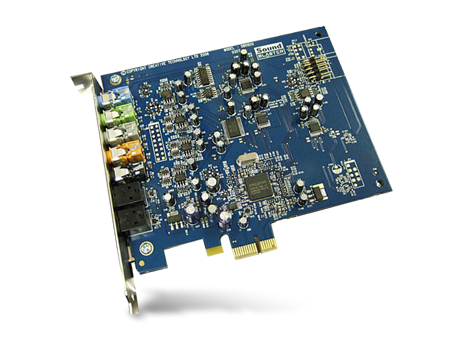Sound Blaster X Fi Xtreme Fidelity Sb0790 Driver

64 MB of dedicated memory found on the Fatal1ty Pro sound card via two 48LC32M8A2-75 C (PC133) chips The top-end Elite Pro model was aimed at musicians, bundled with the X-Fi external I/O box (offering phono with preamp inputs for turntables, high-impedance input for guitars, 1⁄ 4 inch mic input, headphone output, line-in, and full size MIDI I/O, as well as optical and RCA Coaxial digital inputs and outputs), and remote control. The Platinum and Fatal1ty FPS models both offer a front-panel drive-bay control unit and remote control, while the base model was supplied without any such accessories.  All but the top model claimed 109 dB, while the Elite Pro model uses a higher-end, with 116 dB claimed. The bottom two models feature 2 MB onboard X-RAM, while the top models offer 64 MB of X-RAM, designed for use in games to store sound samples for improved gaming performance.
All but the top model claimed 109 dB, while the Elite Pro model uses a higher-end, with 116 dB claimed. The bottom two models feature 2 MB onboard X-RAM, while the top models offer 64 MB of X-RAM, designed for use in games to store sound samples for improved gaming performance.

Launch reviews did not support Creative's claims of higher performance, however, with even the top-end 64 MB equipped model falling slightly behind the older Audigy cards. October 2006 saw a minor rebranding: the X-Fi XtremeMusic edition, which was in fact a highly capable gaming card, as it offers hardware decoding and EAX support, was replaced with the XtremeGamer model. The revised model featured half-width PCB, non-gold-plated connectors, optical out instead of the digital out and digital I/O module jack, and lacked the connector for users wishing to purchase a separate X-Fi I/O box. Functionality is otherwise the same. The market segment occupied by the XtremeMusic was moved downwards, with the introduction of the (cheaper) 'Xtreme Audio' and 'Xtreme Audio Notebook' products, which, despite the 'X-Fi' label, are the only products in the X-Fi line not using the EMU20K1 chip ( CA20K1) but an older chip similar to the Audigy SE and SB Live! Cards ( CA0106-WBTLF) and thus lacking the hardware acceleration of 3D sound and EAX sound effects, gaming and content creation features and the I/O extensibility of all the other X-Fi models.
Add the Sound Blaster® X-Fi™ Xtreme Audio PCI Express® sound card to your PC and turn your downloaded music into your own personal concert. Jun 20, 2009 Hi, im running windows 7 (7100) 32 bit. Ive got Creative Sound Blaster X-Fi Xtreme Audio in, ive downloaded the xp, vista and 7 beta drivers from creative, they either say driver version not found OR they say the device isnt plugged in properly, which it is having run it with xp.
The other new product introduced was the X-Fi 'XtremeGamer Fatal1ty Pro', identical in function to the Fatal1ty FPS, but made more affordable by the unbundling of the I/O panel and remote control. In 2007 Creative Technology unveiled x1 and /34 versions of Sound Blaster X-Fi Xtreme Audio during. Creative did not yet release PCIe versions of their EMU-based X-Fi cards as adapting the CA20K1 chip for PCIe proved to be troublesome, with the company itself reporting design difficulties, latency problems and delays. ExpressCard Sound Blaster X-Fi for Notebooks (34 mm with a removable plastic adapter for 54 mm slots).
In 2008 the X-Fi Titanium series was announced, using the revised CA20K2 chip, which featured an integraded RISC processor for safeguarding against PCIe-induced latencies, a DDR SDRAM interface in place of SDRAM, and an integrated High Definition audio architecture (UAA) component. Products included the Fatal1ty cards with 64 MB X-RAM and an optional I/O drive bay, and the regular Titanium with 16 MB X-RAM, but the same 109 dB SNR spec as the former. Unlike the PCI cards, these cards use software-based Dolby Digital Live 5.1 encoding. In 2010 the Titanium HD was added to the lineup, featuring a new DAC with 122 dB SNR and RCA audio outputs, but dropping support for Windows XP. X-Fi USB products [ ] In addition to PCI and PCIe internal sound cards, Creative also released an external USB-based solution (named X-Mod) in November 2006. X-Mod is listed in the same category as the rest of the X-Fi lineup, but is only a stereo device, marketed to improve music playing from laptop computers, and with lower specifications than the internal offerings.
Other external products that use X-Fi name include USB-based Sound Blaster X-Fi HD, Sound Blaster X-Fi Surround 5.1 Pro, and Sound Blaster X-Fi Go! Pro, Their internal hardware components are different for various usages and needs for gaming, surround, or audiophile standards. X-Fi features [ ]. R4 sdhc ds. 4-channel stereo multiplexed WM8775SEDS placed on X-Fi Fatal1ty Pro The audio processor on X-Fi was the most powerful at its time of release, offering an extremely robust sample rate conversion () engine in addition to enhanced internal sound channel routing options and greater 3D audio enhancement capabilities. A significant portion of the audio processing unit was devoted to this resampling engine. The SRC engine was far more capable than previous Creative sound card offerings, a limitation that had been a major thorn in Creative's side. Most digital audio is at 44.1 kHz, a standard no doubt related to, while sound cards were often designed to process audio at 48 kHz.